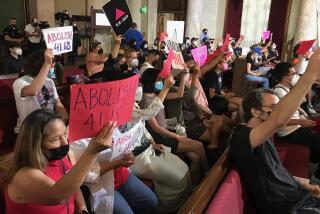L.A.’s Community Care Facilities Ordinance is overkill
Los Angeles has made slow but significant progress toward ending homelessness, but the City Council is about to vote on a proposed law that could stop that momentum in its tracks.
The Community Care Facilities Ordinance would threaten the well-being of thousands of people with disabilities, create a nightmare for property owners, cost taxpayers more, violate principles of fair housing and jeopardize access to federal funds.
The proposed ordinance grew out of an effort to eliminate sober-living homes in residential neighborhoods. In October 2007, Councilman Greig Smith responded to constituent complaints about such homes by introducing a motion directing the city’s Planning Department to look for ways to target them with zoning laws.
Recognizing that an ordinance directly outlawing homes with tenants in recovery from drug and alcohol abuse would violate fair housing laws, city staff instead crafted a far broader ordinance that would bar more than one lease agreement within the same residence. Sober-living houses usually require residents to sign separate leases so that an individual can be evicted if necessary. But the law would also target every other kind of household with more than one lease, along with the often-vulnerable people who live in them.
Virtually every form of federal and state housing assistance for homeless people with disabilities, including shared housing where tenants each have a room and share common areas, requires tenants to sign an individual lease. Individual leases promote independence, and they also prevent a single bad tenant from controlling the fate of all. In prohibiting more than one lease, the ordinance would derail a number of projects that are in the works, including one to transform four abandoned homes in foreclosure into permanent supportive housing for 15 homeless veterans with disabilities.
The law’s passage would also put many people with psychiatric or developmental disabilities who are already living in shared homes at high risk for homelessness, some after decades of living independently. Even families forced by a difficult economy to double up in housing could find themselves outside the law.
Another provision of the ordinance would prohibit more than two people on probation or parole from living in the same building in most residential areas. Even in those areas where it was allowed, landlords would have to obtain conditional use permits to rent to more than two people on parole or probation in a single building. This presents a particular problem for homeless people who can be, and frequently are, arrested simply for sleeping on sidewalks or for other offenses related to their homelessness. It also would probably worsen crime because probationers and parolees are seven times more likely to recidivate when homeless than when housed.
The law’s effect on people with disabilities would be particularly pernicious, undermining recent progress in broadening housing opportunities that make it easier for people with disabilities to live independently in integrated community settings instead of being institutionalized for life.
The ordinance could also threaten the city’s capacity to secure federal housing funds, which require adherence to federal fair housing laws. Los Angeles is already facing a federal inquiry into whether city housing programs are noncompliant with disability rights laws. Civil rights organizations throughout the city agree that the proposed law would violate federal requirements, thus jeopardizing funding. The federal government has weighed in against a similar ordinance in Newport Beach.
The irony is that while the ordinance would end housing projects that do things right, some of the bad apples would continue operating, by simply putting every tenant on the same lease, an option supportive housing providers do not have.
The City Council appears likely to pass the ordinance in coming months. When a motion directing the city attorney to draft it was put before the council last June, Richard Alarcon was the only member to vote against it. Meanwhile, the council member now sponsoring the bill continues to push hard for it, as do the neighborhood councils that first targeted sober-living homes.
Recently, a few council members have expressed some concerns about the breadth of the law, and every city housing agency opposes it. So there is still hope for its defeat.
A far better approach would be to follow the recommendation of a 2010 Planning Department report, which found that the city’s existing “administrative nuisance abatement procedure is the most direct and cost-effective approach to addressing neighborhood concerns” about sober-living homes. If the council truly wants to address the problems neighborhood councils claim are prevalent — excessive noise, loitering, parking problems or other activities negatively affecting neighborhoods — the council should address these issues directly, without regard to the status of the residents.
The Community Care Facilities Ordinance is overkill, and its effect on some of the city’s most vulnerable residents would be disastrous.
Jonathan Hunter is managing director for the Western region at the Corp. for Supportive Housing. Autumn M. Elliott is an attorney in the Los Angeles regional office of Disability Rights California.
More to Read
A cure for the common opinion
Get thought-provoking perspectives with our weekly newsletter.
You may occasionally receive promotional content from the Los Angeles Times.






